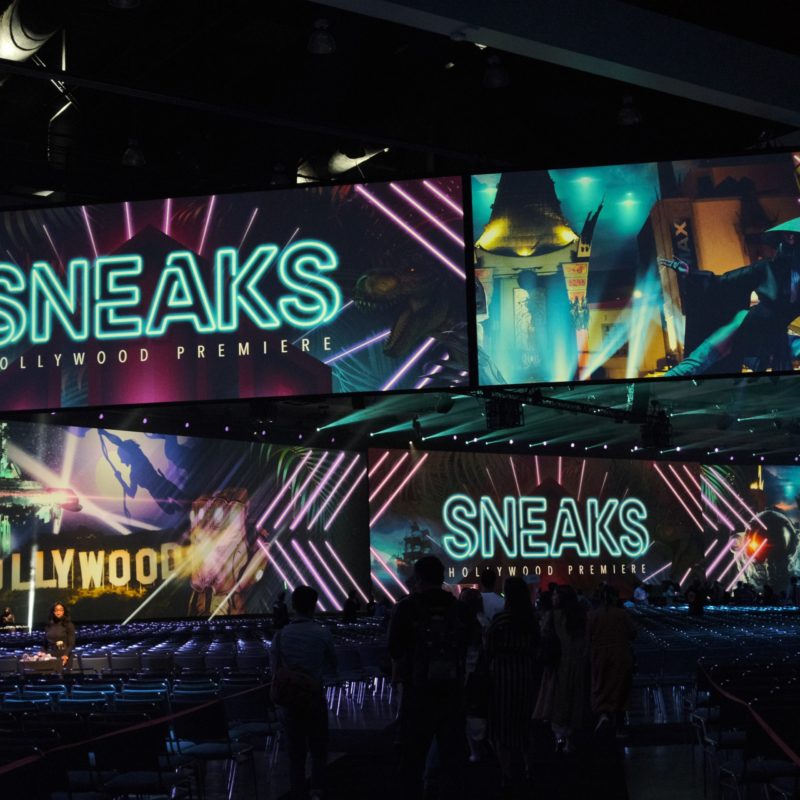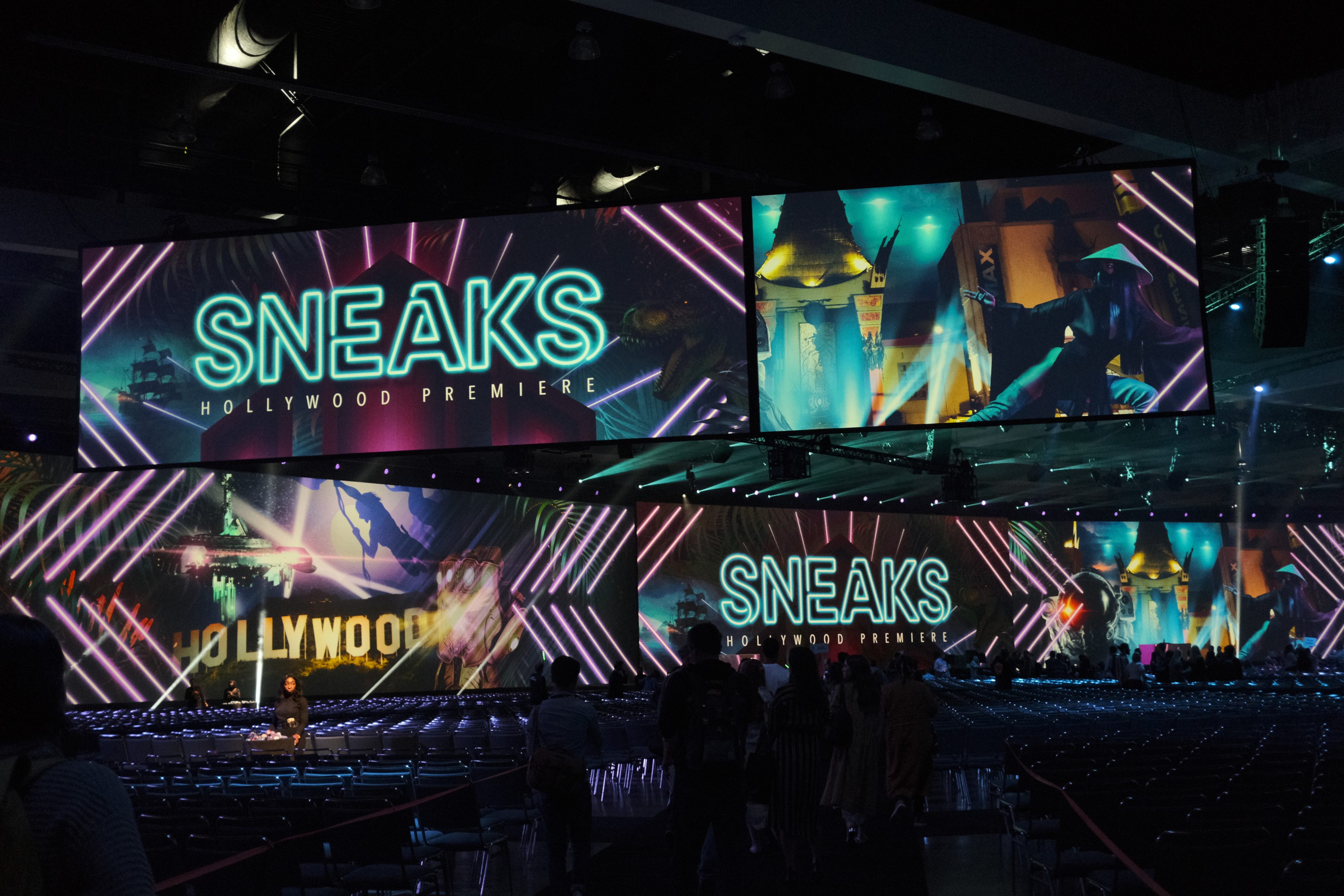
As is now tradition, I live-streamed the first chunk of the morning’s Keynote on the Uber over as I needed an extra hour or so of sleep. All told ~700,000 people were streaming with me.
Whereas Day 1’s presentation was about the tools (Adobe products new and old) Day 2 featured the users of said tools, the artists. We heard from artist Shantell Martin, photographer David LaChapelle, director M. Night Shyamalan, and musicians Billie Eilish and Dave Grohl, of who I owe my drumming chops to almost exclusively.
The message was pretty unified across the speakers, and that was essentially to trust yourself. David spoke about the value in solitude, needing to get away from “the noise” just to hear himself, needing time to find the beauty in pain (dude had a tough life), and understanding that art is what you give not what you receive. Far too many folks get in to these industries for the money (haha) or want to be famous or get invited to cool parties and all that, but that’s not where art comes from. Even Questlove from last year said that you need time to allow yourself to be bored, to just sit with your thoughts.
Night (he goes by Night come to find out) mirrored that thought, saying that when he leaned in to “his weirdness”, when he stopped thinking about the reaction to his work -which is uncontrollable- and focused primarily on the work itself, suddenly it got better. That’s not to say he didn’t have self-doubt or fail. Hell, he stopped writing Sixth Sense for a while when he heard they were making a Casper movie, but once again the work comes from your unique mind it’s not done by comity. He also mentioned an idea that I personally subscribe to, and that is that obstacles, limitations, are good. If you have too many options you’ll freeze up, be uninspired, and at best phone it in. Limitations allow you to challenge yourself, which in turn wrestles the best work out of you.
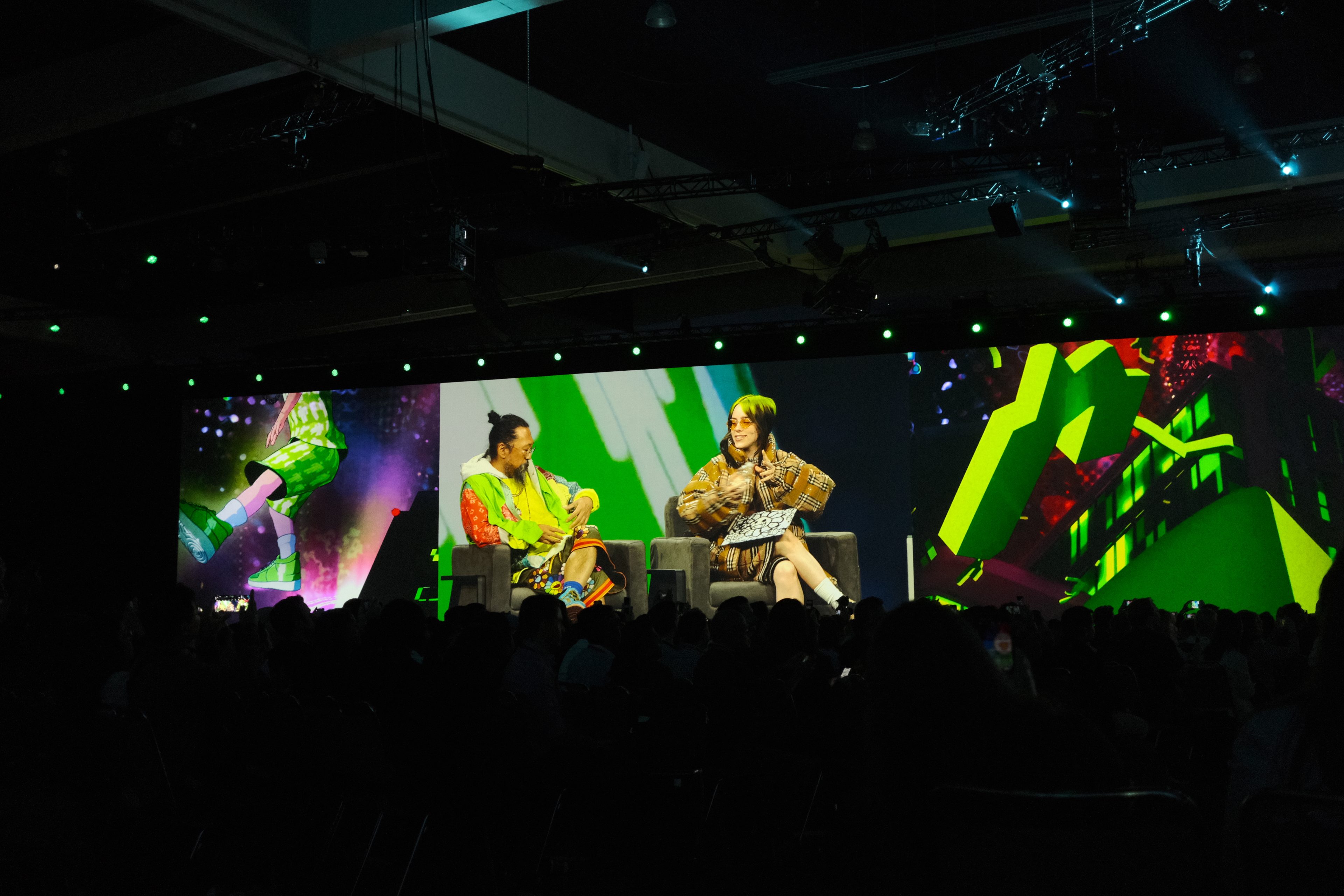
Billie, same thing. Sat beside collaborator Takashi Murakami, she reiterated over and over that her art just comes from what excites her and what inspires her personally, not what “might be cool” through someone else’s eyes. The Billie Eilish you see on stage, wearing those clothes, laughing in the face of opposition, is who she has been her whole life. Night had mentioned later that he met her mom, who speaks to Billie’s seemingly-instant artistic self confidence as a child and that even he could see that when his own kids showed him one of Billie’s music videos. Real recognizes real.
Grohl was the highlight for everyone, but especially me as I basically learned how to drum by listening to Songs for the Deaf and playing along until I had the whole thing licked. My main goal was to be able to play Song for the Dead perfectly without having to slow down or cheat and it took me a couple of years at least. Grohl’s collaborations are almost more legendary than his “regular gigs” in my opinion; Probot, Them Crooked Vultures, Queens of the Stone Age, Killing Joke, Sound City Players… the man is nothing if not a music factory who inspires and lifts up anyone he works with.
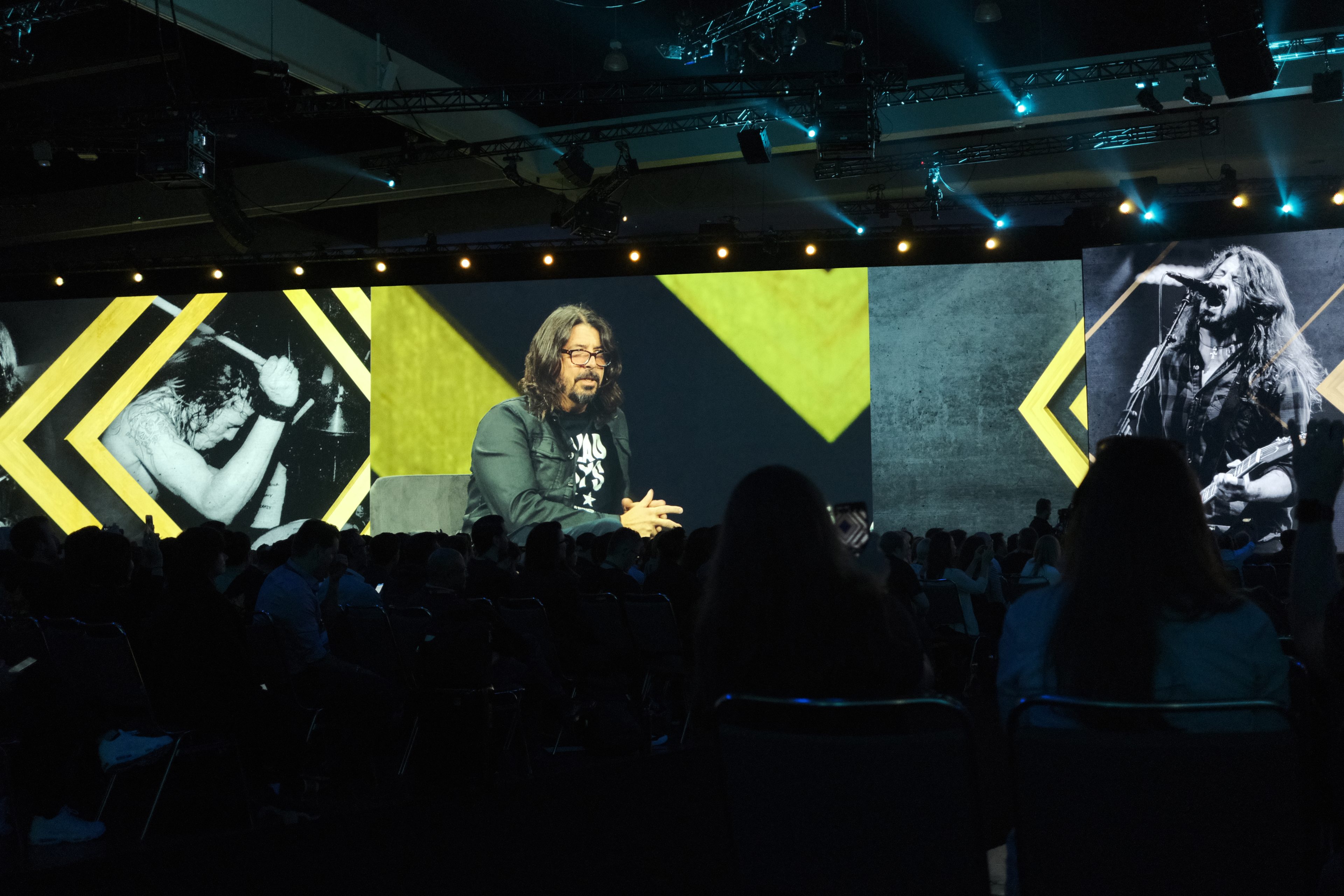
Grohl, again, had a similar message: “love is your greatest muse”, passion is what leads you places. Knowing what you get excited by and being able to articulate that to your audience is what brings success. You’ll know you’ve got something really good when folks who don’t play instruments are compelled to air drum to your song. Dave himself can’t actually read music, having taught himself by ear, but that doesn’t surprise me in the slightest. The MAX audience hit him with a “wow” when he said that, but if I were to guess I’d be the academic types that learned “the right way” to do music are currently teaching it where the folks who were driven to create music by the ether are the ones who you hear about as touring musicians. There is no “right way” there is only “your way”. Of course it’s good to know the ins and outs of your craft, but art doesn’t progress when everyone stays within the “predetermined” boundaries set out by those before you, it gets pushed and expanded upon when people who are driven to create do so without looking at those boundaries. If we all did the same thing none of us would be worth listening to, right?
After leaving the Keynote I went to go grab some food, not wanting to do to myself what I did yesterday, and ran in to my friend Blayne of who I share a last name with. He said Night was doing another talk at the Microsoft Theater, so I followed him and got a good seat. We didn’t know what the talk was about, but as he was a director we figured it’d be film-centric.
It was not. Come to find out we were surrounded by hundreds of educators, students, and academics. The talk was centered around the idea that creativity is a necessary part of human growth and is highly undervalued in the school setting and that lack of emphasis is reflected in resumes. The team involved scoured 2 million resumes and saw that a huge chunk of them didn’t list any creative problem solving or communication skills, even though those are almost always skills that employers say they are looking for. Creativity isn’t an artistic skill, it’s a life skill. You need creativity to be an artist but you don’t need to be an artist to be creative, ya know?
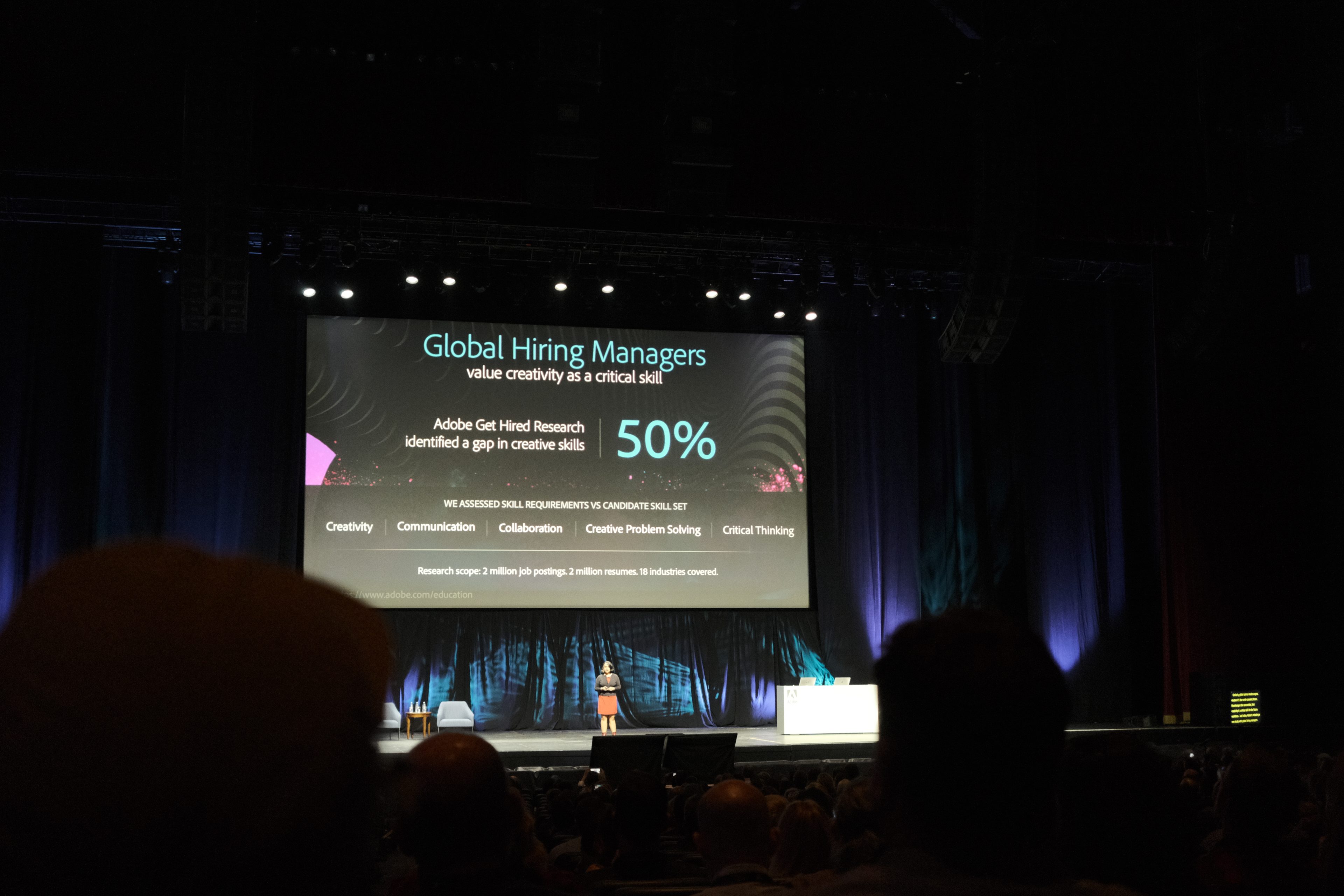
Night took the stage and spoke about how he was incredibly interested in how schools are failing kids, as he comes from a pretty academic background himself. His parents are both doctors, as are a bunch of his friends, and after a handful of years wondering why he (and a team of his helping with the project) couldn’t figure out the solution to the inner-city versus suburban school problem, in regards to performance, he found an analogy that cracked the case. There’s a whole book he wrote about it.
They had been studying factors individually with no real luck, but a friend of his had mentioned that in regards to health if you don’t smoke, eat healthy, get 8 hours of sleep, work out three times a week and (I can’t remember) “brush your teeth”, your likelihood of getting any disease drops by something like 80%. However if you just do four of those things, only leaving out one (let’s say the one I forgot), your chances go right back up to the average. The solution is a holistic one, and just doing a few things isn’t enough. In the same way, they figured out that the solution with education was a combination of factors and the primary one missing was agency.
Night says that kids, traditionally/specifically minorities, are often talked out of their own agency. Whether by society, entertainment, or their surroundings, the world seems to be shouting “shut up, sit down, you don’t matter” and the solution is to shout even louder over that unified voice to get kids to start believing in themselves. One also has to think that, now with the internet, kids from across the spectrum of life are having a hard time seeing a bright future for themselves as the discourse online is by and large doom and gloom. I can say personally I didn’t start seeing success in my life until I stopped talking down to myself and started believing in my own voice, which is insane to say but took something like 26 years of my life to do, so this message really rang true with me. It’s easy to see how beneficial it would be if we could start getting kids (especially the most underserved among us) into a confident space, showing them how regardless of where they’re at, what they look like, or what they feel, their uniqueness -their “weirdness”- is actually power. Night himself said that the thing that made him successful, more than hard work or luck or any of that, was that he “was more willing to be himself than they are willing to be them.” He’s a self-proclaimed eternal optimist on steroids, and truly believes that (combined with proper education, good health, mentorship, all that stuff) agency is the missing key: teaching kids to iterate, to not be afraid of failure, to feel what it is to “be them” and act on it. So anyway watch “Servant” on Apple TV+ this November.
At this point I had fully become aware that I didn’t schedule anything for the time block I was in, and a few things had actually fallen through, so I hung around MS Theater to see the next talk, someone that I’m a huge fan of: Aaron Draplin. I could go on for a long time about what that man means to me, but I can say confidently OWL BOT wouldn’t be where it is today without his lessons taught from afar. His work ethic and business style aside, my logo and brand identity wouldn’t be anything without going over hours of his online Skillshare-style lessons. I’m not a designer, but I did have a rough idea of what I wanted to do with the look and style of OWL BOT and his teachings got me the rest of the way there. I even bought his font, which is now the typeface of my company. I also use Field Notes every day, Anyway, this talk was more about little tricks he’s picked up over the years in Illustrator, a program I’m barely antiquated with. I actually learned a lot, even if I didn’t understand the interface at all.
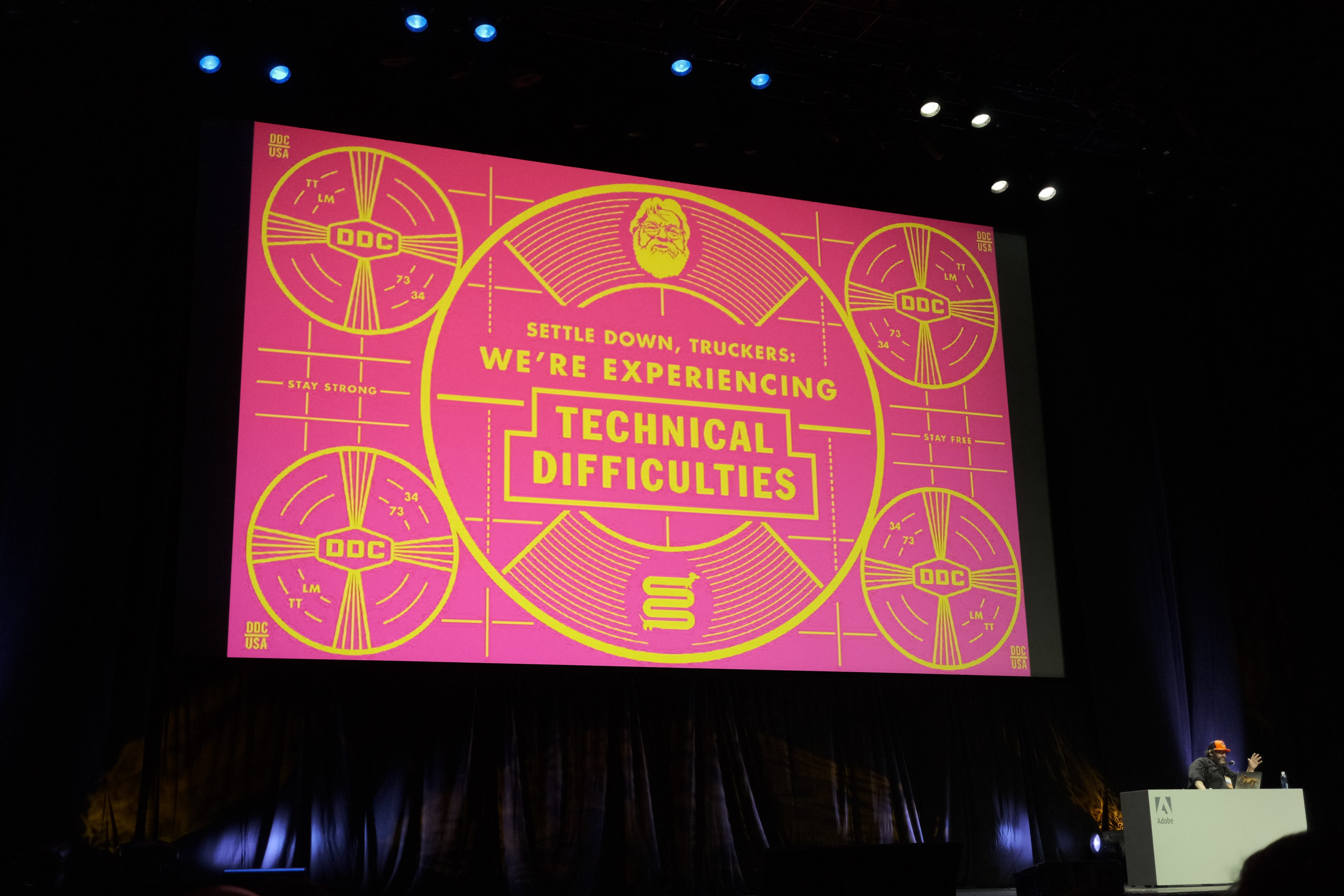
Before he got started he gave us a rundown of who he is and took some time to speak about things that matter to him outside of, if not tangentially related to, design. He spoke about growing up drawing little logos as a hobby, simply putting pencil to paper, and that once the tools came (primarily Illustrator) he was unstoppable. Pencil (or pen if your a savage) is the quickest conduit from which ideas flow in my opinion, and Aaron seems to agree. You can just get the idea out there, modifying quickly, using your hands to build. Once you’ve got the blueprint you can start to build with your finger and mouse in Illustrator, although as I mentioned yesterday there does seem to be a new tool in Illustrator coming that basically builds the whole thing for you after analyzing a photo of your hand-drawn logo so we’ll see where that takes us. As far as I can tell it’s like Live Trace except done via Sensei magic and creates a bunch of intelligent shapes (like making your image proportioned evenly) instead of just a crude outline.
Aaron had a few other things to say, some of which I’ll leave for those of us who were there to remember, but of note he did say that Fugazi taught us to care for one another 27 years ago and that he built DDC Hardware in Illustrator, as he’s not a font maker by any stretch, and that we had “no time for clapping! We gotta get going!” before continuing to rant. Loved it. On his recommendation it would appear I also need to look up Chuck Anderson, House Industries, and Hydro74.
The Illustrator tricks Draplin was showing us were largely about using the program’s internal math against itself to do things the way you want them via shapes and alignment. For instance, the middle of a star isn’t the middle of the bounding box, but if you draw a straight line from the dead-center of two different points (which is another trick he showed) where they intersect is the true center. He mentioned a number of times that shapes in Illustrator don’t always butt-up exactly against each other, and that with a simple rectangle drawn under your to-be-mirrored item and a flip tool that I honestly couldn’t tell you the name of, it will be right every time. It may seem complicated, but it actually takes less steps than the traditional way (which he did show us) and makes sure that there’s no pixel gaps or anything which can cause problems when printing or cutting your design.
He also espoused the value of using simple numbers when making shapes and colors: 10, 25, 50, 75, etc. He apparently gets asked a lot how he gets his colors, and he simply picks a base one and then adds x-amount of Cyan, Magenta, or Yellow to it. So if he had a green block that is supposed to get greener in each successive block, he just adds (for example) 10 units to Magenta in the color picker, moves on to the next block, 10 more units, and onward. This makes things easier to remember, is mathematically sound, and makes it much simpler to explain to someone else what you did if need be.
Another tip was to use the Symbols Palette to save objects you use a lot, like a logo or your signature, but just remember that sending that project to someone will also send the palate so be careful.
Unfortunately I had to leave that session early to meet up with Pat Palmer of Adobe to talk about Premiere. I’m in a weird position where I don’t seem to experience crashes or bugs that often, so I didn’t have too many specific questions on hand. We also got distracted talking about photography, my new XT3 (which I’ll have to do a writeup on if not for the reaction it got at MAX alone), lenses, and theory so there was that. I will say I kind of flubbed this interview, just being in such a nerd-talk mode, but so it goes.
My main line of questioning was around the future of Premiere Pro. As there wasn’t a ton of discussion around it this year I sort of just wanted to know if it had been put on the back burner, so to speak, in favor of tailoring it for individual large productions and new exciting apps, or if that was just a perception of mine.
In regards to the future, the “Pro” in Premiere Pro is never going away. It doesn’t feel like it, but Premiere is kind of new to being used so often in the production space and as such they’re sort of catching up to the demand. By utilizing feedback from huge filmmakers like Fincher, Miller, and the Cohens they’re better able to update the software that will both make the studio-types happy as well as get tools in the hands of the rest of us that are built for battle. Programs like Rush are an onramp to Premiere Pro, not a replacement.
I also wanted to talk about communication. With editing communities online, primarily on reddit, I notice a decent amount of people screaming at the clouds with the sense that they think their specific problem isn’t being addressed. Like I said I haven’t had too many issues to speak of, at least none that were program-breaking for me, so I’ve always figured it was something they personally were screwing up. Pat told me that the best way to get your problem solved is the Adobe Community Forums instead of places like reddit or individual forums solely because Adobe is constantly watching that space, interacting with users, and it’s specifically intended for that purpose. Even an editing forum is a social sphere first with the side benefit of having users who might know the answer.
I also think it’s worth mentioning that if you’re serious about editing or graphics work or 3D or anything like that, it’s in your best interest to use hardware that has been tested to work with the program you’re using. It’s too easy to think that something like a gaming PC’s power is analogous to editing power, and you could be right, but what you give up is stability. Some hardware configurations just don’t play well with certain programs. Puget Systems tests hardware against programs all the time, so if you’re building a computer it’s best to use the best hardware you can afford on those lists, and if buying a computer either compare the specs to it or buy a system built for workstation use. In terms of Macs I turn you to the bottom of the page for Adobe’s Premiere system requirements page..
Another issue is updates. It’s always advised to not upgrade Premiere in the middle of a project, which I can understand could be hard if you have multiple overlapping projects, but it’s equally as important to leave driver updates until you’re at a good stopping place too.
Pat did tell me that there is a program coming up where it will scan your system and tell you which is the offending piece of hardware which I think will do a lot of good so I’ll find some more information on that for you as I don’t currently know the status of that or if it’s currently available. Keep an eye out for that.
We were quickly whisked out of our meeting room and we headed to the main hall for Adobe Sneaks. This is where we got to see demonstrations of new things being cooked up in the Adobe kitchen. This is more or less the event that kicks off MAX Bash, so this year they had John Mullaney co-host the presentation. Armed with an IPA I sat down and settled in. I would summarize the various projects for you but Adobe just sent me a list so I’ll just reproduce that for you here with any comments I have added in:
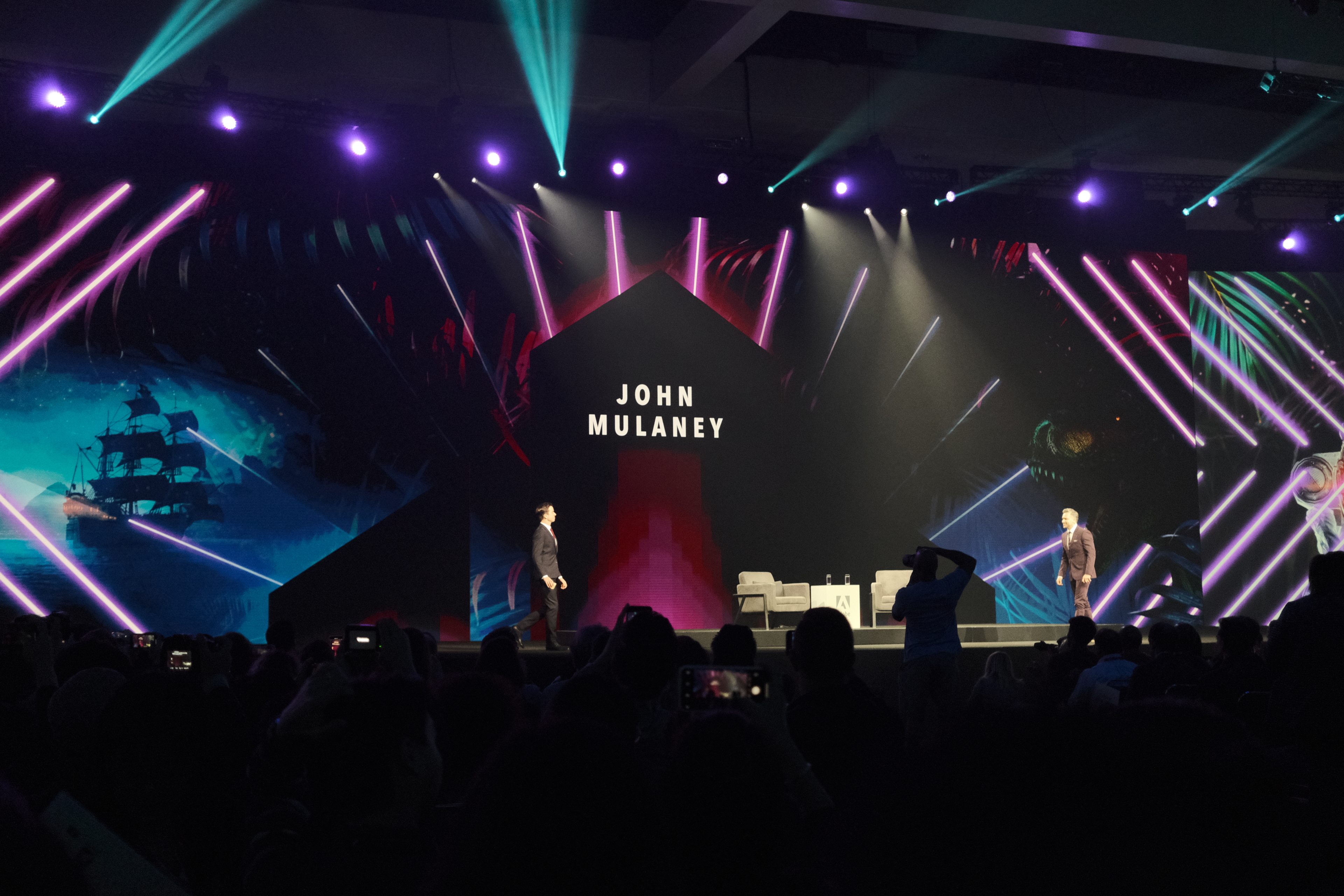
1. #AllinSneak
“When taking group photos, people usually take turns as the photographer, so one person is always missing from the photo. Powered by Adobe Sensei, Project All In eliminates the need for a tripod and a timer by automatically identifying and adding missing people so that no one gets left out.”
This seemed to work pretty well, only needing you to clean up some edges on the person comped in. As a filmmaker I’d just say make sure to have the people that would be next to them stay in so the shadows match. The program won’t comp them over anyway.
“Content creators are constantly looking for specific sounds that occur multiple times in audio recordings. Wouldn’t it be great if you could simply select a couple of target sound examples, and have a machine find the rest? Boom. *Powered by Adobe Sensei.”
“From still to in-motion, Project Sweet Talk creates dynamic videos from static images. The possibilities are endless: animate drawings from centuries ago, random sketches, 2D cartoon characters, Japanese mangas, stylized caricatures, and casual photos. *Powered by Adobe Sensei.”
Creating an AR application today requires heavy technical expertise. Project Pronto combines the benefits of both video prototyping and AR authoring into a cohesive system that allows non-technical designers to rapidly express AR design ideas.
“Whether used as an inspirational tool for designers or to bring sketches to life, Project Image Tango mixes two assets to create a new image that has the detailed shape of one and the intricate texture of the other. *Powered by Adobe Sensei.”
This straight up looked like magic. This is amazing.
“In today’s digital world, animated texts are used everywhere. While popular, the process of converting text to animated keyframes is tedious and tiring. Project Fantastic Fonts provides predefined effects so that a previously exhausting task is now quick and painless.”
“The ability to track a person is critical for editors as they produce videos, but it’s not easy. Project Go Figure makes it possible to track using skeletons and contours, enabling smooth and robust tracking even in a crowded scene. *Powered by Adobe Sensei.”
“Quickly solve the challenge of relighting outdoor photos and videos with Project Light Right. Relighting outdoor videos and images has long remained beyond the reach of the casual photographer, especially when it comes to large-scale outdoor scenes, where controlling the lighting is close to impossible. Light Right quickly solves the challenge with 3D scene geometry. *Powered by Adobe Sensei.”
This was also magic. Just watch the video. The results went from “pretty realistic” to “incredibly realistic”. Just awesome.
“Enhances amateur audio recordings and turns them into professional-sounding recordings with the click of a button. The technology helps with enhancements such as denoising, dereverbing, equalization, and environment matching so that you can take your audio to the next level. *Powered by Adobe Sensei.”
If this isn’t in the next release of Premiere I will be livid. If it works as well as it did on that stage it’ll save you hundreds on iZotope products.
A plugin that allows people to enrich their artwork by “painting with light” in Adobe Illustrator. The integration of a simple 2D path tracers might just open up a whole new area of 2D illustrations.
“Automatically detect facial features and adjust them to enhance a portrait or add a creative character to a fun shot. Project About Face also allows you to identify and undo these adjustments to revert back to the original image. *Powered by Adobe Sensei.”
After getting excited for the future we headed straight to Staples Center for MAX Bash, which is essentially a giant cocktail party followed by a concert. Where the reception is a great place to network and talk to the sponsors about their various products, Bash is where you get to have some fun. You’ll probably talk about business anyway, as it’s unavoidable at this conference.
This year, Bash was held at Staples Center/LA Live. In Staples, all of the food vendors and bars were open, offering smaller portions and a selection of beer and wine for free. It’s a really strange feeling to just walk around Staples taking things as you see fit but it’s a fun one! There was also an area on the roof and outside in the street for people to hang out in the beautiful night air, which kept things from getting too cramped, complete with bars and installations of their own. I can’t describe the feeling of just wandering around that area surrounded by so many like-minded people with that energy floating around, but it’s incredibly exciting.
After a couple hours, we headed inside for a private concert by Vampire Weekend, and after that headed home.
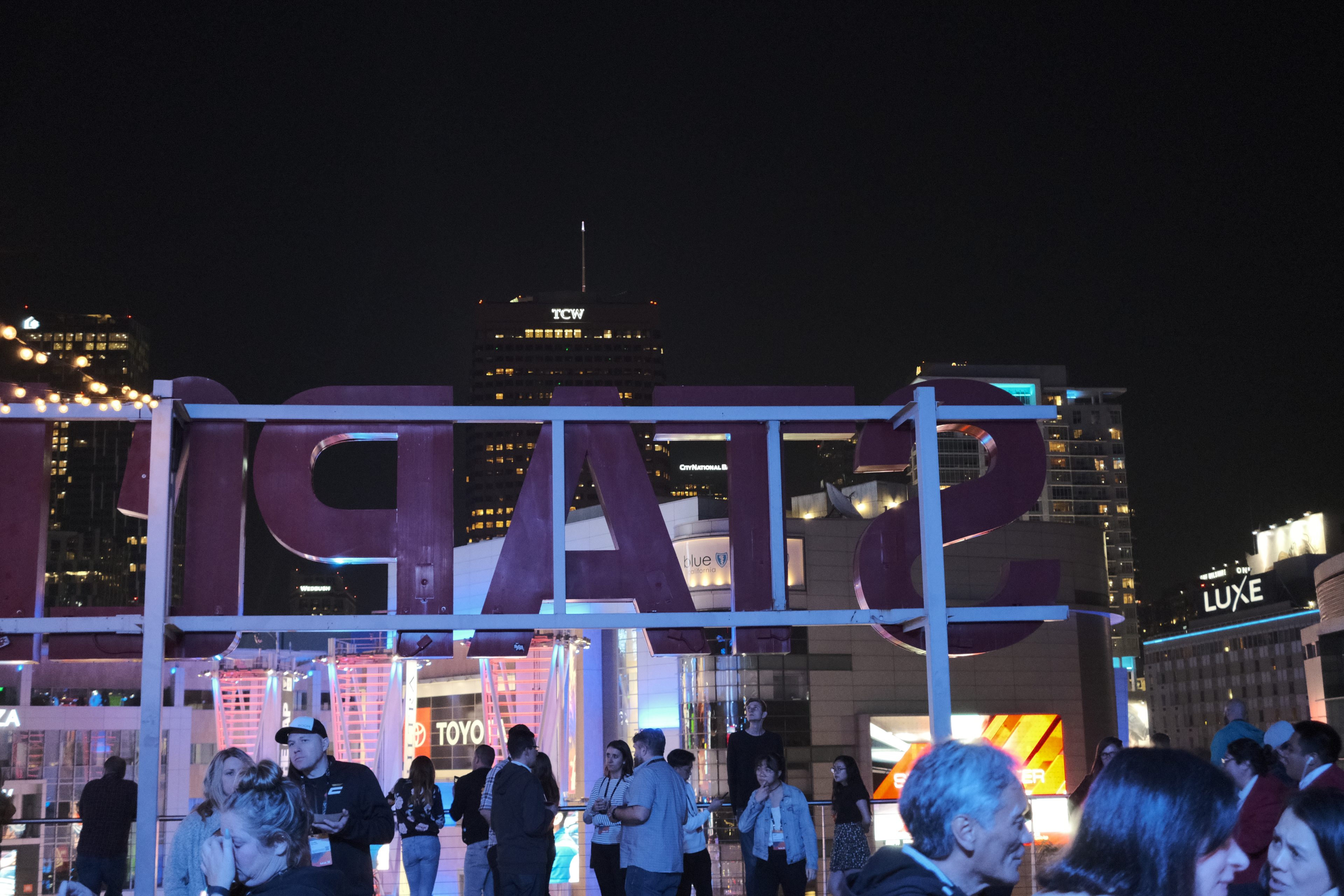
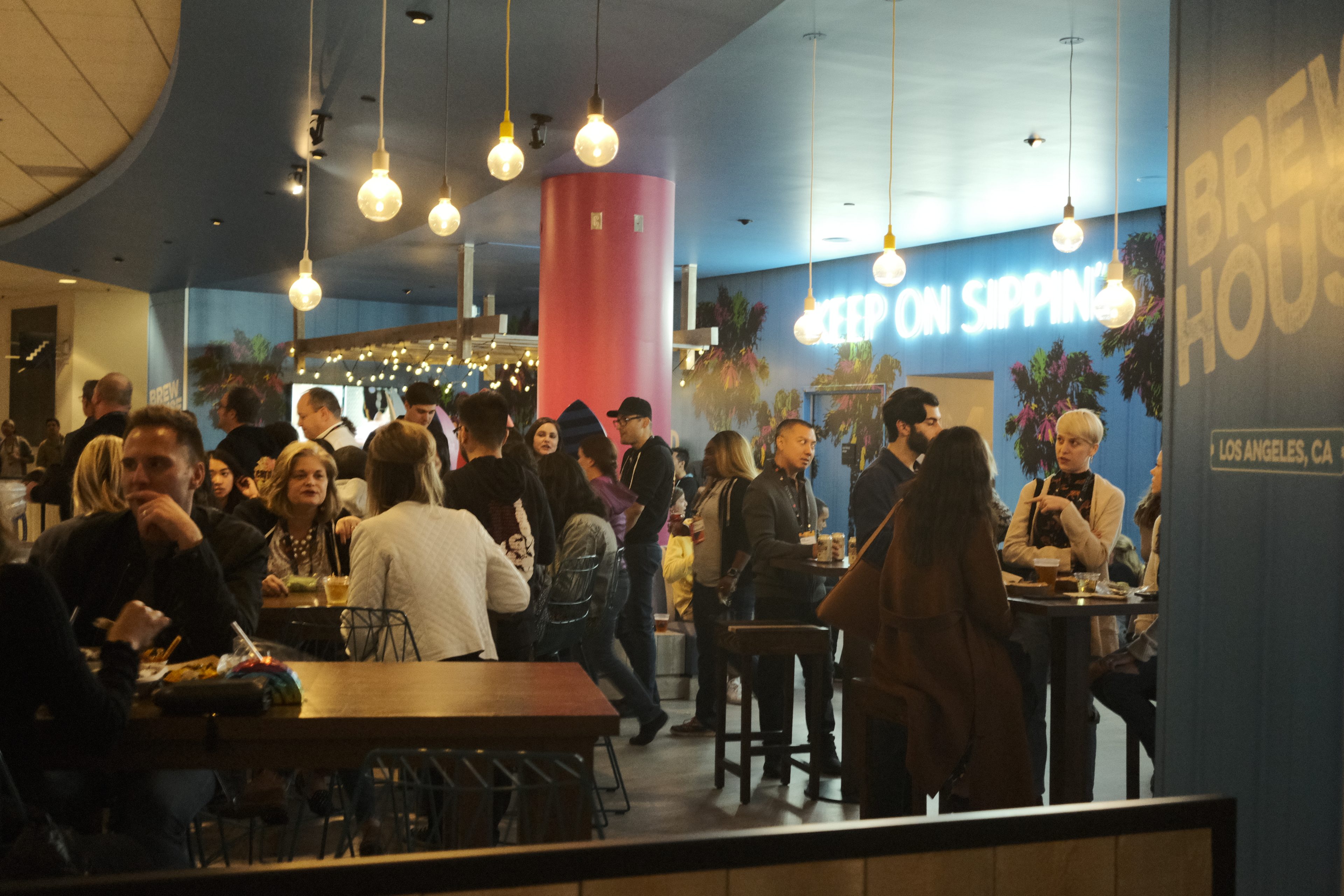
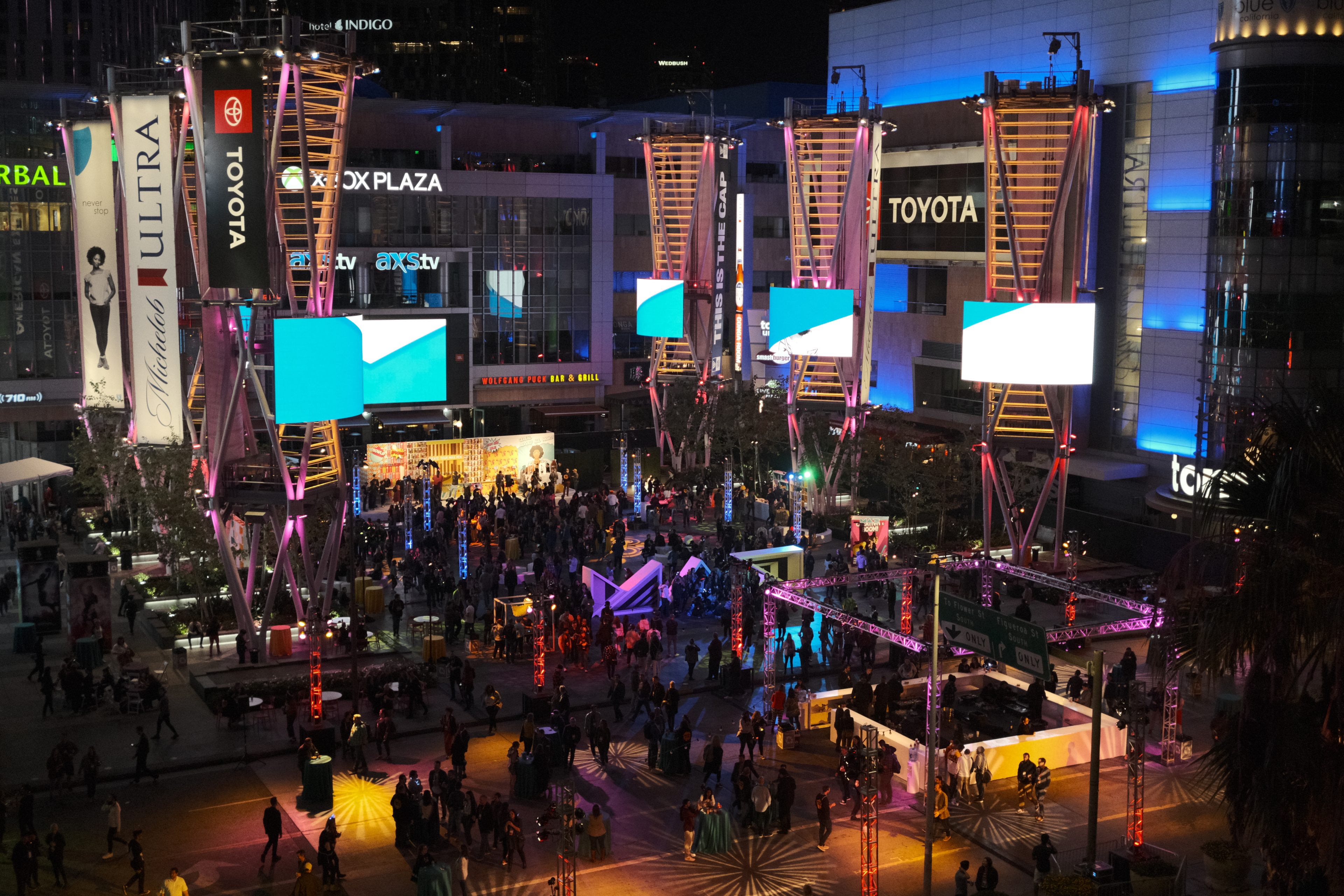
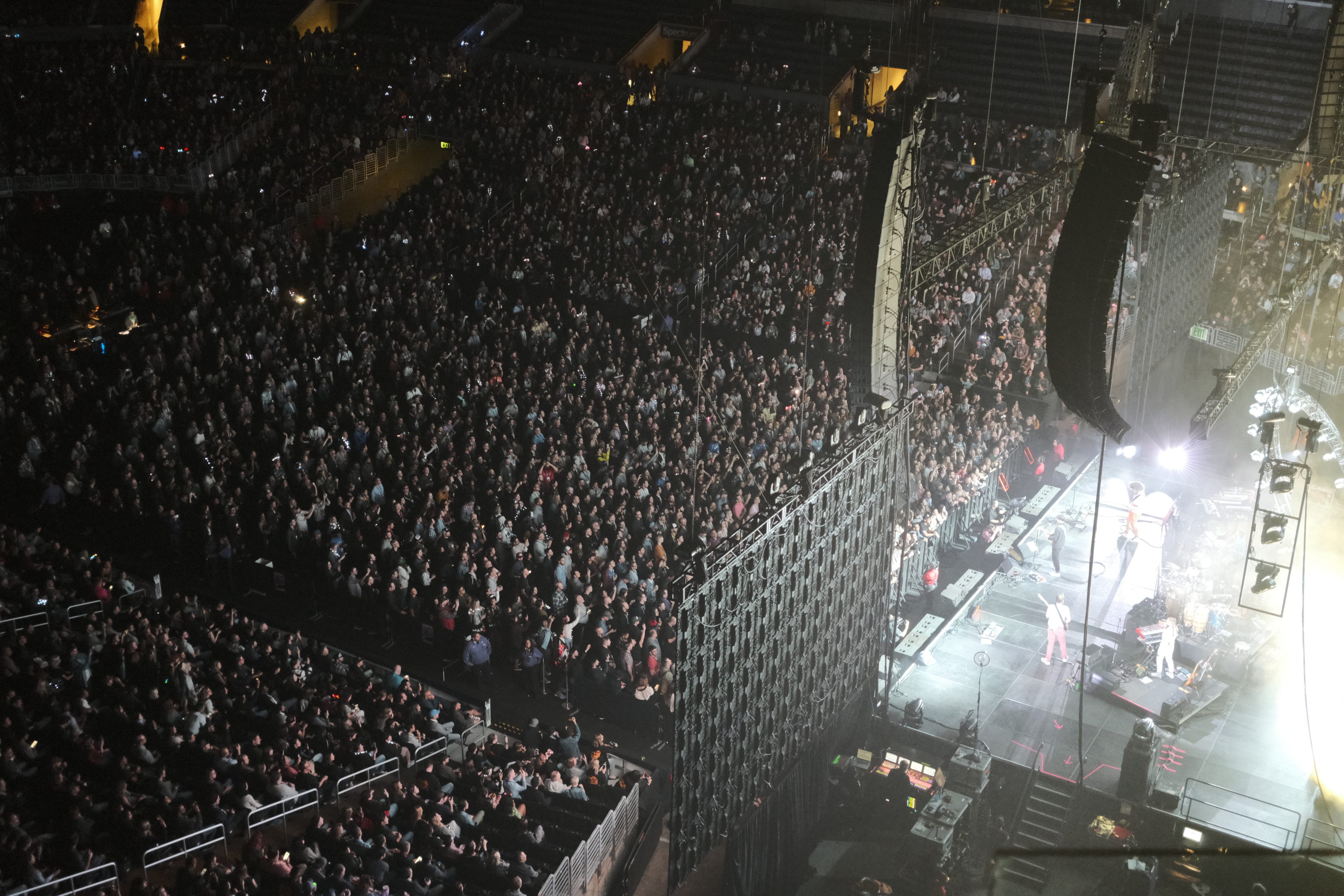
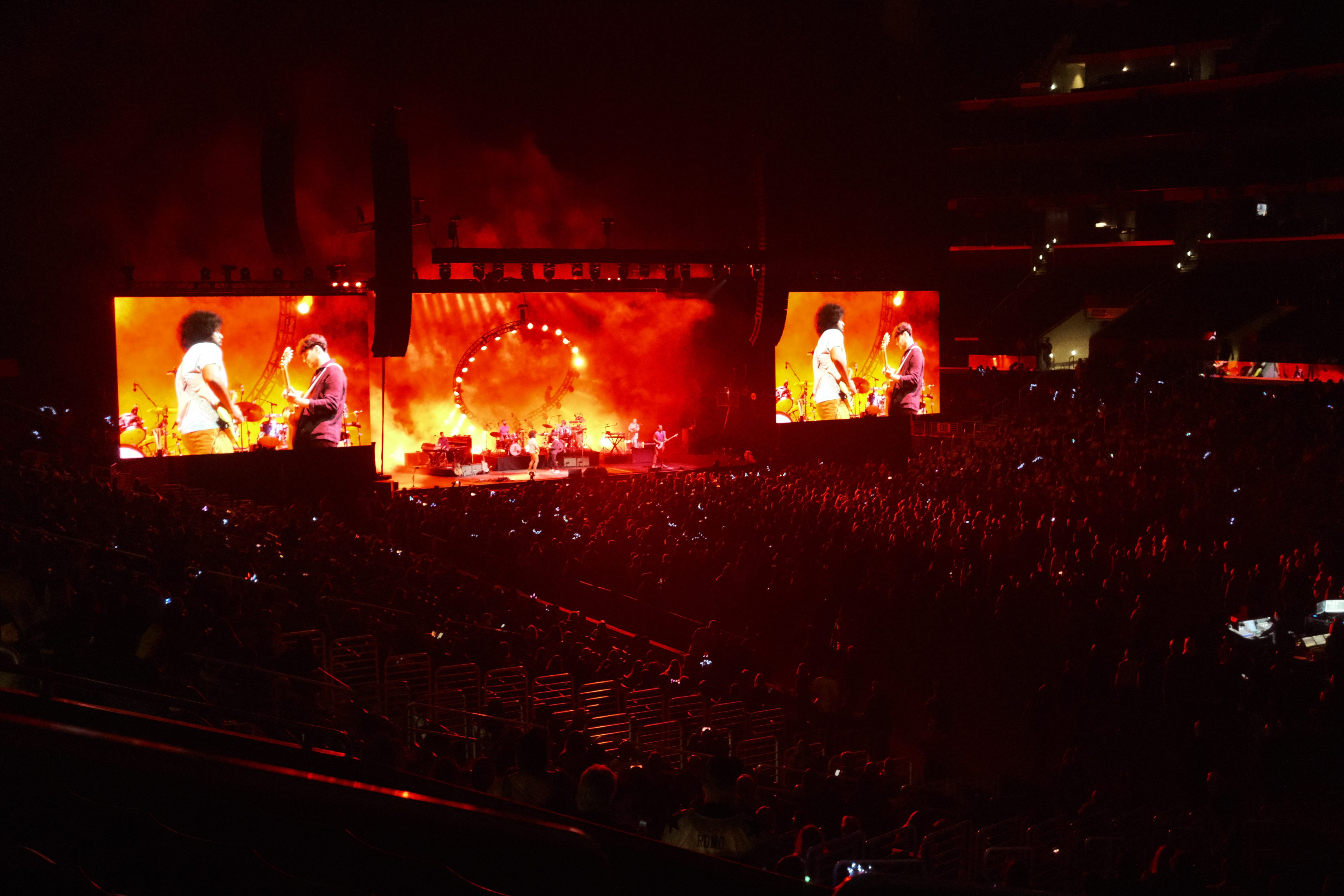
Now, my plan was to go back for Day 3 to do a final lap of the Pavilion and see who else I could talk to, maybe even take in a couple courses, but unfortunately my regular work schedule caught up with me. The third day doesn’t have any large events or Keynotes but it’s the perfect time to knock out any meet ups or classes that you may not have taken before.
Adobe MAX is a difficult conference to convey, but I hope I’ve done a good enough job this year. If I’m fortunate to be able to return next year, I would love to take in a few of the classroom-style lectures and talk about those but there’s just so much going on it’s hard to do it all. You would never be able to go to MAX and say “yeah I had a few hours off so I took a nap”. This year I got to meet people I admire, people I’m happy to have met unexpectedly, made new friends and linked up with old ones. I learned from the speakers but learned even more from the people I spoke to out on the Pavilion. Can’t complain there.
If I had to give any advice to those of you thinking about going, it would be to just attend whatever sessions interest you, regardless of whether or not you feel like you’ll understand the material or if it’s “relevant” to you. I can say confidently that many of my “methods” in regards to filmmaking are taken from musicians I admire, as well as specific photographers and designers. Be sure to talk to everyone you run in to and see where they’re from. There’s so many interesting people visiting on behalf of so many amazing, sometimes surprising companies that you’re guaranteed to learn something new as their experience wouldn’t be on your radar. MAX is the kind of event (I don’t even consider it a conference) that, for a few days, blocks out the day-to-day and allows creatives to think creatively around their colleagues. Both times I’ve been now I’ve left energized and really wanting to get after it which is a blessing in and of itself. Especially in LA, it can be difficult to stay motivated and excited about your art when it often is such a “job”, but MAX is a well-needed shot in the arm and I’m glad it exists.

Filmtools
Filmmakers go-to destination for pre-production, production & post production equipment!
Shop Now